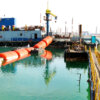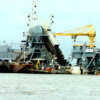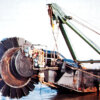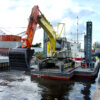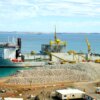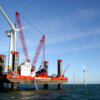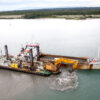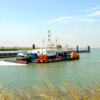Grab or clamshells dredgers are very commonly used, rather simple and easy to understand stationary vessels, with and without propulsion.
Work method of Grab or clamshell dredgers
Grab or clamshell dredgers have either a rotating cab or fixed A-frame-type barge-mounted equipment. They have hoisting and control systems and use grab (clamshell) digging devices or buckets rigged on cables to excavate the material from the waterbed at or near its in situ density and transport it vertically out of the water and into barges for subsequent transport to the placement area. Normally they are stationary, being fixed at the excavation site using anchors or spuds.
The discharge of the material is usually done by transporting it with barges. However, some grab cranes are placed on self-propelled hoppers, so the material is transported by the dredger itself. Also, for grab dredgers used for winning sand and gravel, material may be discharged to a separator installation through conveyor belts.
Advantages
The grab dredger’s advantages are its ability:
- to dredge in fairly deep waters
- to carry out precise spot dredging,
- to remove isolated areas above grade either in the navigation prism or along dock walls and in corners of docks.
Types of material
Grab dredgers can be used in sands, clay, gravel, cobbles and occasionally broken rock.
Limitations
They are not particularly effective in fine silts, which have a tendency to run out of the bucket. However, they are used for this purpose in smaller jobs or when fitted with special sealed buckets.
Production rates
Depending on the type of material dredged, they have moderate to low production rates.
Project applications
The large grab dredgers are used for bulk dredging. Smaller grabs are mostly used for special jobs, such as:
- not easily accessible places in harbours
- small quantities in strongly varying depths
- along quay walls where the soil is damaged by wires and debris
- borrowing sand and gravel in deep pits
- sand and gravel mining
- moraine areas, that is, areas with an accumulation of unconsolidated glacial debris where big stones can be expected.






